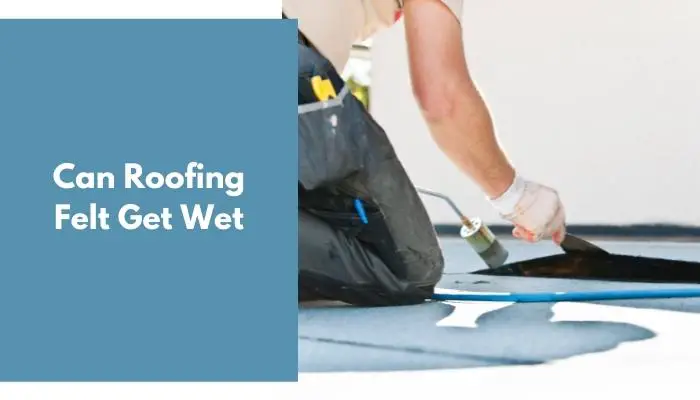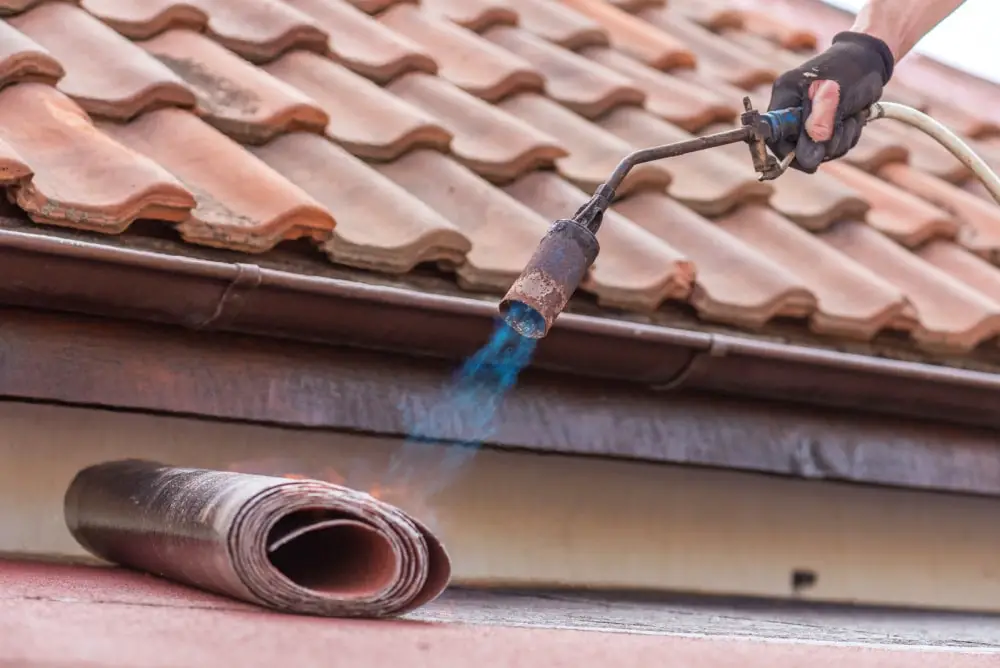Tar paper referred to as roofing felt, is a protective outer layer commonly used between plywood and roof. This material has a combination of polyester and fiberglass.
Roofing felt can get wet. It can protect your roof from water damage. But, it can still get damaged due to excessive moisture. It can also break down in sunlight due to its composition.
This article will teach you the fundamentals of roofing felt, and what you can do in case it gets wet.
Contents
What Is Roofing Felt?
A good roof has various components, such as felt. When it comes to building a roof, the first important thing is to make sure that the structure is structurally sound.
The roof of a building comprises a combination of felt and shingles, which helps absorb and release any water underneath the surface. It allows the structure to endure the harsh weather while remaining secure.
A common type of felt is tar paper, a variety of underlayments usually made from wood. Sometimes, a water-repellent coating covers the area.
Types of Roofing Felt
Various types of felts are used for roof repairs, such as torch-on, self-adhesive, and shed felt. The most common are the thick ones made to protect the roof from water damage and roll in a wide range of sizes.
Self-adhesive Felt
If you’re not planning on hiring a professional to install the felt on your roof, then self-adhesive felt might be the best option. This method does not require hot flames and does not require the homeowner to get professional help.
This product only requires peeling off the paper bottom to install it on the roof. Since it’s only an adhesive, it’s the easiest way to install it in small areas like the garage or the porch.
It’s also a more cost-effective alternative to buying new roof tiles. However, it’s still vulnerable to accidents since it doesn’t require professional help.
Torch-on Felt
A torn-on felt roof originates from modified bitumen, which is melted onto the top using a blow torch.
This type of roof lasts for around 15 to 25 years, depending on the weather conditions in the area. Due to the dangerous effects of burning, this type of felt roof requires skilled workers.
The most common type of roof installation in the UK is the torn-on felt, a quick and reliable technique. This type of felt comprises various components such as cap sheets, vapor control sheets, and reinforced felt.
Shed Felt
The ideal option for people looking to build or renovate their outdoor garden buildings is the use of shed felt.
You can use this versatile material in various applications, such as self-adhesive and torch-on. Its waterproof and weatherproof finish makes it an appealing choice for people planning to protect their outdoor projects.
What to Do if Your Roofing Felt Is Already Wet?
It is probably okay if you are experiencing the worst-case scenario and your roof is already wet. However, roofing felt is better than just taking the damage when managing moisture.
Before you start working on your roof, make sure that your felt is in good condition. If it’s wrinkled or torn, it could signify something wrong with it.
If your roof is just wet, then the next question is what you plan on doing next. If you want to start shingling, then you might want to let the felt dry. Doing so could cause the roof to tear. We are trying to avoid this by allowing the felt dry.
Getting the roofing felt dry can be a lengthy process, so it’s good to consider getting some tarps to help you finish shingling quickly. However, a leaf blower can be a great alternative if you need an immediate solution.
If you are not ready to start shingling yet, start by blowing air on your felt. This method is far less harmful than nails.
After a while, you can finally start shingling. Although it is a little fragile, it is essential to take good care of it to last for a long time.
How Long Does Roofing Felt Last?
The lifespan of a roof felt depends on its type, weight, and weather conditions in the area. There are many preventive measures you can accomplish to extend its lifespan.
Placing things that don’t need to be there can cause the weight to shift around on the roof, tearing the felt. Even if the top surface of the roof has not been disturbed, it’s still essential to avoid damaging it. Some types of felt can are repairable, while others can’t.
If the felt gets damaged or rips, it’s important to immediately fix it to prevent further damage and prevent it from developing rot. Doing so will help avoid excessive warping and mold growth. The exact repair method depends on the type of felt you use.
When carrying out regular inspections, it’s essential to avoid hailstorms, heavy rain, and snow.
These weather phenomena can cause structural damage and even cause water to pool on the surface of your roof. One way to check for signs of this is by looking for areas of your roof that are still damp.
What if the Roofing Felt Is Wrinkled or Torn?
When dealing with wet felt, we are most concerned about the tearing and the splitting. It is because both scenarios can lead to the same issue.
When a shield gets exposed to prolonged exposure to rain, it can get warped and misshapen. It is not an effective shield, and you should replace it. We want to make sure that no holes in the felt protect our roofs.
If you notice that your roof’s felt is getting wrinkled or torn, it’s probably time to replace it. Doing so doesn’t mean that you have to replace all the felt, just the damaged areas.
As long as the felt doesn’t overlap, it shouldn’t be too hard to cut out a piece of it and replace it with something else. Since there are more layers of roofing felt than just one layer, I always suggest buying more.
Frequently Asked Questions
Can You Install Shingles on Wet Roofing Felt?
It will help if you do not lodge shingles on wet roofing felt. If you’re planning on installing new roof shingles, make sure that you don’t place them on damp roofing felt.
Doing so can prevent the trapped moisture from wreaking premature aging. In addition, improper installation can cause the roof to look older.
If the felt is wet, it will cause the roof to blister. However, once it dries out, it will allow the bubbles and wrinkles to relax, which will enable the shingles to look better.
How Long Does It Take for Roofing Felt to Dry?
You should wait at least 24 hours before installing new shingles on your roof. Doing so should take a couple of days, depending on the size of the top. In the US, most homes have a roof over 1,600 square feet.
Since it can handle up to three days to place new shingles on a roof, it can take you up to two to three days to cover the entire surface of your home.
Doing so could compromise the felt’s integrity. It’s important to tear down the old roof and replace it with a new one that you can fix in a day.
Why Should You Want to Have Felt on Your Roof?
The ice and snow on the roof can melt during freezing weather and cause water to seep into the house. It can lead to water damage. Fortunately, a layer of felt can prevent water from entering the house.
Due to the state’s hot and dry climate, wildfires are a severe concern in Arizona. Class A fire-rated asphalt shingles and other combustible materials are essential.
Conclusion
Roofing felt can get wet. Despite its inherent risks, such as water damage and accidents, roofing felt is still one of the best ways to protect your roof from getting damaged in the future.
It can also help prevent water from getting into the top. However, it’s still essential to follow proper installation instructions and the manufacturer’s guidelines.







